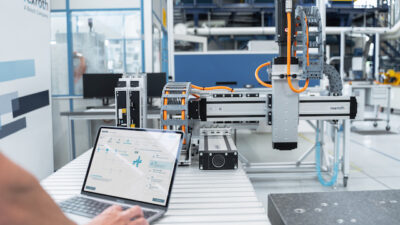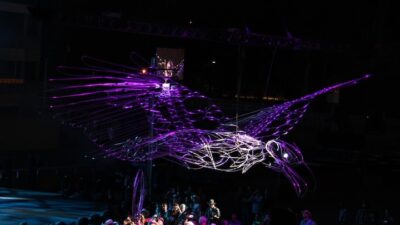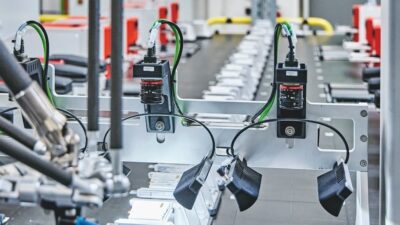Systems theory requires studying the whole to learn about the interconnectedness of the parts, says Fritjof Capra in The Web of Life, rather than just the Cartesian study of parts. "Ultimately, as quantum physics showed so dramatically, there are no parts at all. What we call a part is merely a pattern in an inseparable web of relationships," he says.
KEY WORDS
Machine control
I/O systems
Embedded control
Open architecture
Networks and communications
Sidebars: Market study predicts I/O product growth Deploying wireless Ethernet Online
Systems theory requires studying the whole to learn about the interconnectedness of the parts, says Fritjof Capra in The Web of Life , rather than just the Cartesian study of parts. ‘Ultimately, as quantum physics showed so dramatically, there are no parts at all. What we call a part is merely a pattern in an inseparable web of relationships,’ he says.
This thought applies directly to evolving concepts of control architecture. The evolution
From centralized controller and racks of local I/O modules;
Through remote I/O racks and distributed I/O modules;
To various types of distributed intelligence… means a growing web of control relationships in a factory or process.
Several advances in technology have made this possible. One is the advent of high-speed networks designed for industrial applications. Another results from advances in microprocessors and circuit-board packaging techniques that enable ever greater processing power in smaller packages. Still another lies in programming software.
The infamous ‘fieldbus wars’ are gradually resolving into an interoperable network of networks. Most networks are now open standards, some originally championed by companies. Industrial networking seems to be settling on such networks as Profibus, DeviceNet, ControlNet, FOUNDATION fieldbus, Interbus, and the newest open network pushed by Mitsubishi Electric Automation (Vernon Hills, Ill.), CC-Link. Venerable Modbus is still widely used.
Ethernet wins war
The wild card in the mix is Ethernet. Several companies have Ethernet I/O products, with more coming on board. Modbus over TCP/IP is used by many. FOUNDATION fieldbus HSE is based on Ethernet technology. DeviceNet and ControlNet contain a protocol called CIP, which enables communication over Ethernet TCP/IP. Profibus Trade Organization has announced technologies that will enable Profibus to work with Ethernet. Look for a factory web of I/O-level networks connecting to Ethernet with the latter sometimes used for control, as well as information.
Thomas O’Hanlan, president and ceo of Sealevel Systems (Liberty, S.C.), offers support for Ethernet, ‘The current industry forecast is for Ethernet products to quadruple in the next four years. We are actively pursuing product development in this area.’
Microprocessor advances combined with falling prices and more memory have greatly advanced suppliers’ ability to add intelligence, networking, and control to smaller devices. First PID control in I/O modules, then motion.
As John Weisenberger, distributed I/O products marketing manager for Rockwell Automation (Mayfield Heights, O.), puts it, ‘We put network processing out in the I/O devices, and found there was a lot of horsepower left over. Local processing leads to increased response time and ability to default control locally in case of network or main controller fault.’
For another advantage of intelligence and networking, look at DVT’s (Norcross, Ga.) vision sensors. Its diagnostics/application sharing software allows engineers at a distance from the actual process to make changes, add information, or troubleshoot the devices.
Programming advances
Powerful function blocks within Ladder Diagram make setting up PIDs or motion control reasonably easy for an engineer. Networking support, including TCP/IP for Ethernet, is now usually built in. Thus, software support for the hardware advances makes all the technology usable.
What does this web of control mean for control architecture specifically? Benson Hougland, director of technical marketing for Opto 22 (Temecula, Calif.), states that there are too many layers involved in typical I/O architectures today. This, he reasons, leads to too much middleware, which causes higher costs, unreliable performance, difficulties in maintaining many different components, and delays in data delivery.
Mr. Hougland proposes a solution of I/O systems that can communicate natively with all enterprise devices, systems, and databases in the architecture. The devices would use standard technologies like XML for data transfer, SNMP for network management, SMTP for e-mail, etc.
There are other benefits to distributed intelligence besides data management. What about the control system itself? In today’s difficult manufacturing climate, control engineers are under even more pressure than usual to wring more productivity out of the system.
Vince Tullo, GE Fanuc Automation’s (Charlottesville, Va.) senior vp, suggests, ‘The right I/O system can improve system speed, increase reliability, and decrease costs. In particular, engineers need to consider response time, diagnostics, redundancy, scalability, and modularity.
‘When fast reaction time is needed, intelligent I/O products remote from the central CPU offer an advantage. One CPU and two I/O bus scan times are eliminated. Often, if the system is designed correctly, the engineer may find that by distributing the processing, the speed requirements on the CPU and I/O bus decrease, reducing system cost and complexity.’
Control architecture evolves
Mike Berryman, Advantech Automation’s (Cincinnati, O.) product manager, explains (in the diagram accompanying this article) the evolution of control architecture. Embedded controllers with built-in I/O points, web server, and display can replace many parts previously required in the construction of a system. This lessens complexity, as well as cost.
Scalability inherent in these new systems is a crucial benefit. With parallel wiring and rack-mounted I/O modules, adding to the system could be expensive. If, as often happens, all spare rack space in the PLC chassis is used, then adding more I/O modules could be almost impossible.
Bill Peisel, chief technology officer for NetSilicon (Waltham, Mass.), says this improved scalability means it is almost always possible to add more remote I/O points. ‘Also,’ he adds, ‘the engineer is able to change functions performed by the devices more easily. This is a little like structured programming. Each device has its function, and you only need to know that function to make changes. You don’t necessarily need to know the entire system.’
Distributed intelligence and control can extend to field devices as well. Cutler-Hammer/Eaton’s product manager, Rich Harwell, notes, ‘While intelligent operator interface is firmly entrenched, similar stories are playing out across other device types. Motor control devices that were previously interfaced through a few I/O points to ‘start/stop’ and ‘check a run bit’ can now direct-connect to the controller. This allows the exchange of far richer information, such as jam and stall detection, three-phase current values, detailed fault codes, and thermal operating conditions.’
Diagnostic capabilities
Omron Electronics’ I/O product marketing manager, Bill Arnold, says, ‘By adding greater diagnostic capabilities to distributed I/O modules, we can now detect failed sensors, opened wires, and short circuits. The key is to improve uptime and facilitate troubleshooting.’
In past debates about ‘open’ versus ‘proprietary’ control solutions, open proponents touted the power given to customers to configure the type of system best suited to their applications. Bringing this discussion into focus, National Instruments’ (Austin, Tex.) networking group manager, Chris LeBlanc, notes, ‘Real-time control in our I/O system solution makes it possible to create a customer-defined embedded controller for discrete, analog, PID, fuzzy logic, or other applications for network or standalone operation.’
In a view from the front lines, Eric Biss, Entrelec’s (Irving, Tex.) eastern region automation engineer, says, ‘Modular node design makes manufacturing floor testing far more streamlined. In cases where the customer would like to become truly brand independent, intelligent fieldbus nodes can be hosted by an upper level PC-based system.’
Where can distributed intelligence expect to go?
Paul Ruland, AutomationDirect.com’s (Cumming, Ga.) PLC and I/O product manager, states, ‘Increased demand for specialty modules at distributed I/O nodes has been most notable in the area of motion control. Advancements in microprocessors and acceptance of Flash ROM are allowing high-speed counter modules to be designed as mini-coprocessors that operate asynchronous to the distributed I/O network scan.’
Dave Skelton, Phoenix Contact’s (Harrisburg, Pa.) director of automation systems, says, ‘The most recent additions to intelligent I/O modules have to do with safety and pneumatics. The added safety function provides a category four safety relay built into the I/O module to simplify wiring. Adding pneumatics reduces the need to wire valves without adding an additional drop to the network.’
Sensor intelligence
Richard Russell, product marketing manager for networks and distributed I/O at Siemens Energy & Automation (Alpharetta, Ga.), predicts, ‘As a general direction, we see distributed I/O as the evolutionary gateway to embedded sensor intelligence. Thus, we feel the sky’s the limit on further embedding functions.’
So no one gets the feeling that all this discussion is theoretical, Charles Cook, Wago Corp.’s (Germantown, Wis.) technical manager for advanced electronics, relates, ‘Customers have added our I/O systems to a PC-based system with the application written in Microsoft Visual Basic. All they needed was a DLL [dynamic link library] file to create an Ethernet link.’
One last networking scheme remains to be broached wireless. There are several competing wireless methods ranging from Bluetooth to Ethernet 802.11 to WAP (for mobile telephones). Products are appearing using each of these technologies.
Ken Hall, Rockwell Automation’s vp of architecture, reports that Rockwell has settled on wireless Ethernet, 802.11, because, ‘Most problems can be solved with this technology. The first thing people are doing with this is programming, because they are comfortable with the software. The second application is mobile operator interface. Still to be determined is if people will move beyond wireless data collection to actual control. Few people doing that now, so it is rare.’
Wireless networks
Phil Danner, GE Cisco’s (Charlottesville, Va.) director of technology, points out, ‘With wireless networks, users can move freely around a facility without losing network connections. Also, cable can be costly and time consuming to install and maintain. Finally, cabled systems have difficulty keeping up with adds, moves and changes.’
Michael Sullivan, Schneider Electric Automation’s (North Andover, Mass.) business development operations manager, foresees using WAP technology for alarm checking and diagnostics through the use of cell phones.
If you are not employing it now, distributed intelligence is definitely in your future. How will it be employed? Just think of your automation system as a web of relationships. Define each relationship within the context of the entire web. Now go, and charge up that productivity.
Market study predicts I/O product growth
Analyst firm Venture Development Corp. (VDC, Natick, Mass.) has issued a report titled ‘Global Markets and User needs for Industrial Distributed/Remote I/O, Second Edition.’ The study provides market size, segmentation, and forecasts for distributed/remote I/O products used with distributed control systems (DCSs), PC-based control systems, and programmable logic controller (PLC) systems. The authors investigated user needs regarding both hardware and related software.
The study found that combined worldwide shipments of these distributed/remote I/O products totaled about $2.2 billion in 2000. When segmented by type of controller, the results were:
PLC……………. systems 46.3%
DCSs………………………. 40.5%
PC-based systems……..13.2%
VDC projects overall worldwide markets for these products will grow at a compound annual growth rate (CAGR) of 6.6% from about $2.2 billion in 2000 to over $3 billion in 2005. VDC examined plans of users, which included OEMs, system integrators, end-users, and others, for future purchases by type of controller application. CAGR findings by controller type were:
PLC…………….. systems 5.9%
DCSs……………………….. 4.0%
PC-based systems………15.0%.
DCS solutions grew out of requirements of heavy process industries. In such applications, requiring thousands of I/O points, DCSs will likely remain the preferred alternative, but not without competition from the other controllers, according to the study. The authors find PLC suppliers invading process-control markets, and doing almost everything a DCS can do with, perhaps, a weakness in terms of redundancy. A significant trend is the use of ‘hybrid’ controls that incorporate PLCs into DCSs.
The study concludes that the more complex the control system, the more PC-based control systems become viable alternatives. PC technology’s flexibility lends itself to products, markets, and time frames exhibiting greater levels of fluctuation, while its inherent web connectivity is a key selling point.
Authors also looked at the type of network used to connect these I/O devices. Companies are increasingly implementing or evaluating Ethernet as the best available solution. Products with Ethernet interfaces accounted for $246 million in 2000, or about 11% of the total. These are forecast in the report to account for $802 million in 2005, or about 26% of the total and about 67% of the total increase of products over the study’s five-year span.
The report cautions that developing new generations of Ethernet equipment appropriate for industrial environments will be essential for Ethernet products achieving the anticipated increase.
Deploying wireless Ethernet
There is no doubt that implementing wireless connectivity to smart I/O devices can solve many problems in manufacturing and SCADA applications. For instance, connections within rotating equipment have been difficult to install and often unreliable. Running wires to remote points can be expensive, especially if changes in the physical plant necessitate additional or changed I/O devices.
Although several methods and standards exist, many manufacturers are settling upon Wireless Ethernet IEEE 802.11b. This standard was designed to promote interoperability with office LANs. It defines both addressing and over-the-air protocols with a goal to promote interoperability.
What would a control engineer need to consider when implementing that first wireless Ethernet system? Ron Chapek, Iotech’s (Cleveland, O.) business development manager, shares some insights.
‘The first step,’ he states, ‘is to determine how much data is to be transmitted and how quickly it must be transmitted. Also, the amount of latency that can be tolerated must be understood. The first information will determine the amount of throughput needed. The latency will determine how much data can be sent at one time.’
Once the engineer has determined these data, preferred devices can be winnowed out. Mr. Chapek reminds that more throughput requires higher over-the-air data rates, which result in poorer receiver sensitivity, which results in shorter range. This potentially impacts system cost.
Next, the designer must determine the architecture. How many remote devices to be connected will determine whether to operate a one point-to-multipoint network, multiple point-to-point links, or some combination.
Finally, consider the location of devices. Location of the factory device will determine the general location of the remote wireless device, while the nearest point of the wired network will control the base wireless device. As a rule of thumb, antennas for all devices should be placed as high as possible without placing them behind an obstruction. While 2.4 GHz is considered a line-of-sight frequency band, in factories, there are usually sufficient surfaces to reflect signals to provide communications without line-of-sight.
Online
For more information and I/O products from Comtrol, Digi, Parvus, Rockwell Automation, and Sealevel Systems, please see this article online at



